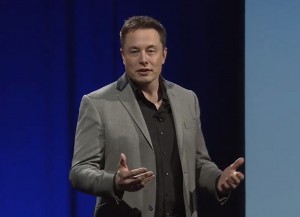
Tesla's Elon Musk said the long-awaited Model X will hit showrooms in the last quarter of this year.
After a two-year delay, Tesla finally plans to bring its much-anticipated second product line, the Model X battery-electric SUV, to market within the next three to four months.
The California-based manufacturer also expects to start offering its new auto-pilot, a semi-autonomous driving system, in the coming months, said CEO Elon Musk during Tesla’s annual shareholder’s meeting. Musk also suggested he is looking forward to a time when rocket launches to Mars become relatively routine, possibly by the SpaceX private rocket company he also controls.
The Model X is expected to greatly expand the potential audience for Tesla’s products considering the strong demand for utility vehicles. Like the Model S sedan, it will feature a fully electric drivetrain that is expected to be offered with a variety of different battery-pack sizes and performance levels.
The production model is expected to carry over the unusual “falcon wing” doors first shown on a prototype version several years ago.
According to Tesla, it already has tentative orders for at least 20,000 Model X utes. The company estimates it will sell about 55,000 vehicles in 2015, including the current Model S sedan. Tesla is, meanwhile, working up a third offering that will be aimed at a more mainstream audience, the Model III.
Along with the environmentally friendly nature of the company’s products, Tesla has been pitching its high-tech approach to car design. Virtually all key vehicle functions in the Model S are operated using a laptop computer-sized touchscreen that dominates the instrument panel.
The maker also has designed its vehicles to allow extensive technical updates to be automatically uploaded to the vehicle. One recent update was intended to improve the range and performance of older Model S sedans. And Tesla is preparing to launch its autopilot feature which will allow limited hands-free operation on limited-access highways.
“It is simply meant as a driver-assist feature,” Musk explained during the shareholder’s meeting, and not as a true autonomous vehicle system. But fully hands-free driving is on Tesla’s agenda, he noted, suggesting that his “best guess” is that fully autonomous technology will be in place within three years.
(Tesla loses money in Q1 and expects Model X to debut in Q4. For more, Click Here.)
“With each passing year, my estimate for when it happens gets closer,” added Musk. “This is both interesting and alarming.”
Tesla is just one of the many automakers working on autonomous driving, a list that also includes established manufacturers like Daimler AG, General Motors and Nissan, the latter promising to have its first fully autonomous vehicle in production by 2020. High-tech giant Google also is working on autonomous technology, though it is expected to seek a partner, rather than trying to build cars of its own.
Proving that his vision of the future isn’t bound by gravity, Musk also used the Tesla event to discuss plans for his rocket company, SpaceX. When asked if it would follow Tesla’s lead with an IPO, the South African-born entrepreneur cautioned that is not one of his short-term goals. In fact, he said, that he doesn’t see that happening until rocket flights to Mars become relatively routine.
(Click Here for details about why Consumer Reports called its Model S “undriveable.”)
SpaceX has long-term goals, Musk noted, that would not be “super-loved” by potential investors.
The company is currently focused on closer reaches of space. It has so far had nine successful supply missions to the International Space Station (ISS) and is working on an advanced version of its space capsule which could begin ferrying astronauts to the ISS before the end of the decade.
In business developments, Musk also noted that Deepak Ahuja, one of the few remaining executives who have been with Tesla since its founding, 12 years ago, will be leaving the company.
(To see how Panasonic will help Tesla launch its new gigafactory, Click Here.)
“Together, we overcame the challenges of the early days at Tesla,” Musk said. “As our first CFO, he guided us through several investment rounds, led the effort to take Tesla public, helped us become a strong business based on solid gross margins, and built a very strong finance team.”


EVs have some value for utility vehicles like local delivery trucks where large battery banks can be stored. The cost vs. the return however must make sense to any potential consumer and so far it doesn’t.
There was an interesting commentary I recently read that alleged that all of Musk’s commercial endeavors are based around tax payer based grants and incentives and not necessarily a solid traditional business strategy. It was noted that Musk’s greatest asset was his ability to convince politicians that Elon’s green tech is valuable for society and the politicians reelection campaign. The grant money supplied to SpaceX, Tesla and now the Gigafactory substantiates the point of the commentary, considering none of the entities actually makes money, despite the creative accounting practices used. In years to come will Elon Musk be known as the guy who pulled the biggest Giga scam on the U.S. government and tax payers?
It is no secret that his business model is centered around pouring all income back into R&D for improving current products and developing new ones. This results in the current absence of profit, and is a central part of his long term strategy – Musk has stated repeatedly that he doesn’t expect Tesla to turn a profit for at least several more years. SpaceX was recently valued at US $10B and is widely reported as currently profitable after the only other major player in the game, United Launch Alliance (a joint venture between Boeing and Lockheed Martin), failed in lobbying attempts to keep SpaceX from fulfilling government launch contracts (which are not grants) worth several billion dollars over the next year. So, that’s my 2 cents on the issue.